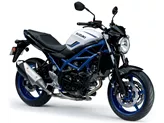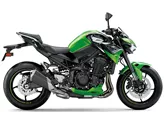Kawasaki Z900 2020 vs. Honda CB650R 2021

Kawasaki Z900 2020

Honda CB650R 2021
Overview - Kawasaki Z900 2020 vs Honda CB650R 2021
The Kawasaki Z900 2020 and the Honda CB650R 2021 are both naked bikes that offer powerful performance and stylish designs. However, there are some notable differences between the two models.
In terms of engine power, the Kawasaki Z900 2020 comes out on top with 125.4 HP, while the Honda CB650R 2021 falls slightly behind with 95 HP. This means that the Z900 has a more powerful and thrilling ride, making it suitable for riders who crave speed and adrenaline.
When it comes to torque, the Z900 again takes the lead with 98.6 Nm, while the CB650R offers 63 Nm. This higher torque allows the Z900 to accelerate quickly and effortlessly, providing a more exhilarating riding experience.
Both bikes feature a four-cylinder engine and a liquid cooling system, ensuring optimal performance and preventing overheating during long rides. They also have fuel injection systems, which enhance fuel efficiency and provide smooth throttle response.

Kawasaki Z900 2020
In terms of suspension, both bikes have upside-down telescopic forks at the front and swing arm suspensions at the rear. The Z900 offers additional adjustment options with preload and rebound adjustments, while the CB650R only has preload adjustment. Both bikes use monoshock shock absorbers and have aluminum components in their rear suspensions.
In terms of braking systems, both bikes have double disk brakes at the front with four pistons. However, the CB650R features radial technology, which enhances braking performance and provides better control during sudden stops. The Z900, on the other hand, utilizes petal technology, which also offers excellent stopping power.
Both bikes come with ABS as part of their advanced rider assistance systems, ensuring safer and more controlled braking in various road conditions. The Z900 goes a step further by offering additional features such as riding modes, ride by wire, and traction control, providing riders with more customization options and improved handling.

Honda CB650R 2021
In terms of dimensions and weights, both bikes have similar front and rear tire widths and diameters, as well as the same wheelbase length. However, there are slight differences in seat height and kerb weight. The CB650R has a higher seat height of 810 mm compared to the Z900's 795 mm, making it less suitable for taller riders. The CB650R also weighs slightly less at 202.5 kg with ABS, while the Z900 weighs 210 kg with ABS.
In terms of strengths, the Z900 stands out for its powerful four-cylinder engine, great handling, good equipment, aggressive looks, and value for money. On the other hand, the CB650R is praised for its Neo Sports Cafe optics, suitability for beginners, good price-performance ratio, smooth engine revs, and low fuel consumption.
However, there are also some weaknesses to consider. The Z900 has a somewhat tiring menu navigation system and lacks the option for a quickshifter, which can be a disadvantage for riders who prefer seamless gear shifts. The CB650R, on the other hand, has limited space for taller riders, mediocre equipment, a relatively chubby design, and lacks punch in the lower rev range.
In conclusion, both the Kawasaki Z900 2020 and the Honda CB650R 2021 have their own strengths and weaknesses. The Z900 offers more power, better handling, and additional features, making it a great choice for riders who prioritize performance. On the other hand, the CB650R is more beginner-friendly, fuel-efficient, and offers a unique design, making it a suitable option for riders who prioritize style and affordability. Ultimately, the choice between the two models depends on the rider's preferences and priorities.
Technical Specifications Kawasaki Z900 2020 compared to Honda CB650R 2021
Pros and Cons in comparison
Pros and Cons in comparison
Kawasaki Z900 2020

In terms of price-performance, the Kawasaki Z900 is hard to beat at the moment. With the perfectly tuned engine, the high-quality chassis components and the electronics added for 2020, this naked bike offers everything that sporty riders will be looking for. There is really nothing to complain about, even if the option of a quickshifter would have been a nice extra. Apart from that: great shot, Kawasaki!
Honda CB650R 2021

13 out of a possible 24 points mean 5th place in the large mid-range naked bike comparison test 2021. The Honda puts up a good fight against the technically more advanced competition and can leave a motorbike behind despite its position as an outsider. Pleasing looks, accessible riding and the low price make the shortcomings that were brought to light in the direct comparison fade into the background.
Price Comparison Avarage Market Price Kawasaki Z900 vs Honda CB650R
There are a few key differences between a Kawasaki Z900 2020 and a Honda CB650R 2021. In terms of price, the actual average price of a Kawasaki Z900 2020 is about 30% higher. Compared to Honda CB650R 2021 there are more Kawasaki Z900 2020 bikes available on the 1000PS.de Marketplace, specifically 34 compared to 11. It takes less time to sell a Honda CB650R with 63 days compared to 124 days for the Kawasaki Z900. Since model year 2017 1000PS.de editors have written 46 reviews for the Kawasaki Z900 and 23 reviews for the Honda CB650R since model year 2019. The first review for the Kawasaki Z900 was published on 11/11/2016 and now has more than 93,200 views. This compares to more than 53,700 views for the first review on Honda CB650R published on 08/10/2018.






















